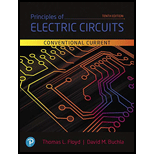
EBK PRINCIPLES OF ELECTRIC CIRCUITS
10th Edition
ISBN: 9780134880068
Author: Buchla
Publisher: VST
expand_more
expand_more
format_list_bulleted
Concept explainers
Question
error_outline
This textbook solution is under construction.
Students have asked these similar questions
Athle phase a.c. distributor AB has:
The distance from A to B is 500 m. The distance from A to C is 800 m.
The impedance of each section is (6+j 8) /km.
A
B
C
The voltage at the far end is maintained at 250 volt.
Find: sending voltage, sending current, supply power factor and
80 A
60 A
total voltage drop.
0.8 lag. P.f
0.6 lead. p.f
The transfer function H(s) = Y(s)/X(s) = Vo(s)/Vi(s) should be found from the circuit given that the initial conditions are equal to 0.
Do not answer using AI Chatbots. PLEASE
A 10kW, 230V, long shunt compound DC generator has efficiency = 82%, armature resistance = 0.15 ohms, series field resistance = 0.1 ohm, shunt field resistance = 100 ohms. What are: armature current, armature voltage across the brushes, generated emf, total copper losses, and horsepower of prime mover?
Knowledge Booster
Learn more about
Need a deep-dive on the concept behind this application? Look no further. Learn more about this topic, electrical-engineering and related others by exploring similar questions and additional content below.Similar questions
- The capacitors in the circuit shown below have no energy stored in them and then switch “A” closes at time t=0. Find v(t) across the 6 uF capacitor for t≥0arrow_forwardConsider the circuit Below: A) Find and show the Thevenin equivalent with respect to terminals a,b B) Find and show the Norton equivalent with respect to terminals a,b C)Find the value of Ro and the maximum power delivered across it when its adjusted such that the power across it is the maximum possible when connected in this fashionarrow_forwardConsider the Circuit Below: A)Find Vo if Vin is 0.2 volts and the positive and negative power supply voltages are +15v and -15v respectively. B)What is the Maximum of Vin that will not hit saturation for this circuit?arrow_forward
- A shunt generator is rated at 125V, 25KW; armature resistance is 0.08 ohms, shunt field resistance is 25 ohms. What are: Armature voltage at rated load, armature power loss, shunt field power loss Total power generated in the armature?arrow_forwardA 12KW, 240V 1500RPM shunt generator has an armature resistance of .02 ohm and a shunt field resistance of 160 ohms. The stray power losses are 900W. Assuming a constant shunt field current, what (1) the efficiency at rated load and (2) the efficiency of the generator at half-rated load?arrow_forward4. Consider the three circuits shown in Figure. Determine each output voltage for (i) V₁ = 3 V and (ii) VI = -5 V. 40 ΚΩ www ww 20 ΚΩ 10 ΚΩ (a) 01 να гля 40 ΚΩ www www 20 ΚΩ 10 ΚΩ ww 10 ΚΩ www (b) www 48 ΚΩ ww -0% 6 kQ 15 ΚΩ (c) оооarrow_forward
- Find the mathematical expression for the points 1 and 2 for this pratical AM-DSB/SC modulatorarrow_forwardQuestion Two A generating station consisting of two generators, one of 20 MVA, 11 kV, 0.18 pu reactance with the unit transformer of 20 MVA, 11/132 kV, 0.08 pu reactance, another of 30 MVA, 11 kV, 0.18 pu reactance with the transformer of 30 MVA, 11/132 kV, 0.12 pu reactance, transmits power over double circuit 132-kV transmission line. Each line is having reactance of 120 ohms per phase. Determine the fault current supplied by the generators to a three-phase solid fault on the 132-kV bus-bar at the receiving end. Neglect pre-fault current and losses. Assume pre-fault generated voltages at rated value.arrow_forward4v+9v+8v=-3v+6v',-5v, where vi and vo are the input and output voltage, respectively.arrow_forward
- I decided to focus on the magnitude where I do the normalization on low and high pass and have the bandpass as dB(dB(decibel), with frequency cutoff, I manage to get accurate but have trouble controlling the frequency cutoff accurately and the bandbass isn't working properly. As such I need help.My Code: % Define frequency range for the plot f = logspace(1, 5, 500); % Frequency range from 10 Hz to 100 kHz w = 2 * pi * f; % Angular frequency % Parameters for the filters R = 1e3; % Resistance in ohms (1 kΩ) C = 1e-6; % Capacitance in farads (1 μF) L = 10e-3; % Inductance in henries (10 mH) % Transfer functions H_low = 1 ./ (1 + 1i * w * R * C); % Low-pass filter H_high = (1i * w * R * C) ./ (1 + 1i * w * R * C); % High-pass filter H_band = (1i * w * R * C) ./ (1 + 1i * w * L / R + 1i * w * R * C); % Band-pass filter % Cutoff frequency for RC filters (Low-pass and High-pass) f_cutoff_RC = 1 / (2 * pi * R * C); % Band-pass filter cutoff frequencies f_lower_cutoff = 1 / (2 * pi *…arrow_forwardPlease do NOT answer if you are going to use AI. Please give a proper solution.arrow_forwardP7.2 The capacitors in the circuit shown below have no energy stored in them and then switch "A" closes at time t=0. Switch "B" closes 2.5 milliseconds later. Find v(t) across the 6 μF capacitor for t≥ 0. 500 Ω B 4 µF 20 V 6 µF 7 Σ2 ΚΩ 25 mA + · μεarrow_forward
arrow_back_ios
SEE MORE QUESTIONS
arrow_forward_ios
Recommended textbooks for you
 Electricity for Refrigeration, Heating, and Air C...Mechanical EngineeringISBN:9781337399128Author:Russell E. SmithPublisher:Cengage Learning
Electricity for Refrigeration, Heating, and Air C...Mechanical EngineeringISBN:9781337399128Author:Russell E. SmithPublisher:Cengage Learning
 Delmar's Standard Textbook Of ElectricityElectrical EngineeringISBN:9781337900348Author:Stephen L. HermanPublisher:Cengage Learning
Delmar's Standard Textbook Of ElectricityElectrical EngineeringISBN:9781337900348Author:Stephen L. HermanPublisher:Cengage Learning

Electricity for Refrigeration, Heating, and Air C...
Mechanical Engineering
ISBN:9781337399128
Author:Russell E. Smith
Publisher:Cengage Learning


Delmar's Standard Textbook Of Electricity
Electrical Engineering
ISBN:9781337900348
Author:Stephen L. Herman
Publisher:Cengage Learning